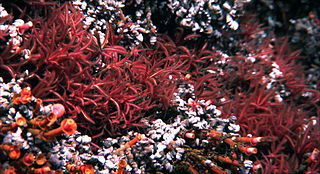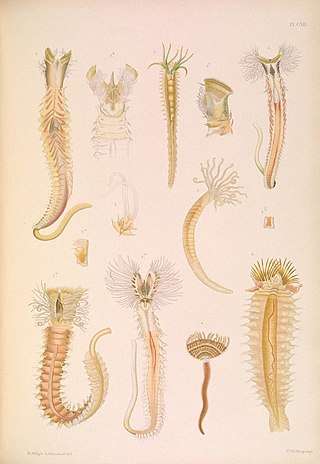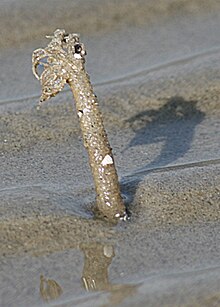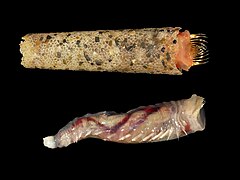
Polychaeta is a paraphyletic class of generally marine annelid worms, commonly called bristle worms or polychaetes. Each body segment has a pair of fleshy protrusions called parapodia that bear many bristles, called chaetae, which are made of chitin. More than 10,000 species are described in this class. Common representatives include the lugworm and the sandworm or clam worm Alitta.

Alvinella pompejana, the Pompeii worm, is a species of deep-sea polychaete worm. It is an extremophile found only at hydrothermal vents in the Pacific Ocean, discovered in the early 1980s off the Galápagos Islands by French marine biologists.

The Alvinellidae are a family of small, deep-sea polychaete worms endemic to hydrothermal vents in the Pacific Ocean. Belonging to the order Terebellida, the family contains two genera, Alvinella and Paralvinella; the former genus contains two valid species and the latter eight. Members of the family are termed alvinellids.

Pectinariidae, or the trumpet worms or ice cream cone worms, are a family of marine polychaete worms that build tubes using grains of sand roughly resembling ice cream cones or trumpets. These structures can be up to 5 centimetres (2 in) long. The earliest pectinariid fossils are known from the Cretaceous.

Ampharetidae are a family of terebellid "bristle worm". As such, they belong to the order Canalipalpata, one of the three main clades of polychaetes. They appear to be most closely related to the peculiar alvinellids (Alvinellidae) which inhabit the deep sea, and somewhat less closely to the well-known trumpet worms (Pectinariidae). These three appear to form one of the main clades of terebellids.

Ampharetinae are a subfamily of terebellid "bristle worm". They are the largest subfamily of the Ampharetidae, of which they contain the great majority of the described genera.

Hesionidae are a family of phyllodocid "Bristle worms". They are marine organisms. Most are found on the continental shelf; Hesiocaeca methanicola is found on methane ice, where it feeds on bacterial biofilms.

Canalipalpata, also known as bristle-footed annelids or fan-head worms, is an order of polychaete worms, with 31 families in it including the suborder Sabellida (families Serpulidae and Sabellidae and the Alvinellidae, a family of deep-sea worms associated with hydrothermal vents.
Swima bombiviridis is a worm species that lives in the deep ocean. It is also known as the green bomber worm or bombardier worm. This deep ocean pelagic (free-swimming) annelid has modified bioluminescent gills that can be cast off from an individual. These discarded gills somewhat resemble green "bombs" that remain illuminated for several seconds after they have been discarded. It is thought that this is a defensive mechanism rather than reproductive, as it is seen in both mature and juvenile individuals. This species was the first of its genus, Swima, to be discovered, and was the only one with a formal scientific name as of 2010. The genus name, Swima, is derived from the Latin, referring to the animal's ability to swim. The species name, bombiviridis, is derived from the Latin prefix bombus, meaning humming or buzzing, and the suffix viridis, which is Latin for the color green. Swima bombiviridis therefore translates to "swimming green bomber".
Swima is a genus of marine polychaete worms found in the ocean at depths between 1,800 and 3,700 meters. Even if they are agile swimmers, they are often seen hanging immobile in the water column as they are neutrally buoyant. This deep ocean pelagic (free-swimming) genus has modified bioluminescent gills that can be cast off from an individual. These discarded gills somewhat resemble green "bombs" that remain illuminated for several seconds after they have been discarded. It is thought that this is a defensive mechanism rather than reproductive, as it is seen in both mature and juvenile individuals. And because they are eyeless, communicating with light would be difficult. Swima worms are closely related to the recently discovered genus Teuthidodrilus, another pelagic cirratuliform of the bathyal zone.
Teuthidodrilus samae, dubbed as the squidworm, is a species of acrocirrid marine annelid worms. It is free-swimming and can be found in the deep sea water column at depths of 2,039 to 2,912 m. It feeds on marine snow and can grow to about 9 cm (3.5 in) in length and 1 cm (0.39 in) in width. It is named for the ten squid-like appendages emerging from its head. It was discovered in 2007 in the benthopelagic zone of the Celebes Sea, near the Tawi-Tawi islands of the Philippines. It is the only species in the genus Teuthidodrilus.

Acrocirridae is a family of polychaete worms. Acrocirrids are detritivores, catching falling particles with numerous long prostomial tentacles. There are eight known genera, and at least 21 described species and subspecies within the Acrocirridae. The acrocirrids are primarily benthic (seabed-dwelling) animals, but at least two genera appear to have evolved or adapted to a pelagic (free-swimming) habitat.

Errantia is a diverse group of marine polychaete worms in the phylum Annelida. Traditionally a subclass of the paraphyletic class Polychaeta, it is currently regarded as a monophyletic group within the larger Pleistoannelida, composed of Errantia and Sedentaria. These worms are found worldwide in marine environments and brackish water.

Lagis koreni, commonly known as the trumpet worm, is a species of marine polychaete worm found in European waters. It lives within a narrow conical tube made of grains of sand and shell fragments.

Palpata is a subclass of polychaete worm. Members of this subclass are mostly deposit feeders on marine detritus or filter feeders. Palpata has become superfluous with the elevation of Canalipalpata to subclass.

Spionida is an order of marine polychaete worms in the infraclass Canalipalpata. Spionids are cosmopolitan and live in soft substrates in the littoral or neritic zones.

Karen Joyce Osborn is a marine scientist at the Smithsonian's National Museum of Natural History Invertebrate Zoology department. She is known for her work in marine biology specializing in mid-water invertebrates.
Gattyana cirrhosa is a scale worm known from widespread locations in the North Atlantic, Arctic, and northwestern Pacific oceans, from the intertidal zone to depths of at least 1,200 m (3,900 ft).

Buskiella is a genus of pelagic polychaete annelids placed either in the family Flotidae or Flabelligeridae. In appearance, they are generally bluish or yellowish, depending on lighting conditions, and live exclusively in very deep water. They move by swinging their bodies from side to side, "rowing with [their] bristles." Species have nine to eleven chaetigers.

Flotidae is a family of pelagic polychaete worms, sometimes synonymized with Flabelligeridae, which they closely resemble. Other sources consider them the sister taxon to Flabelligeridae and closely allied to the latter group.




















